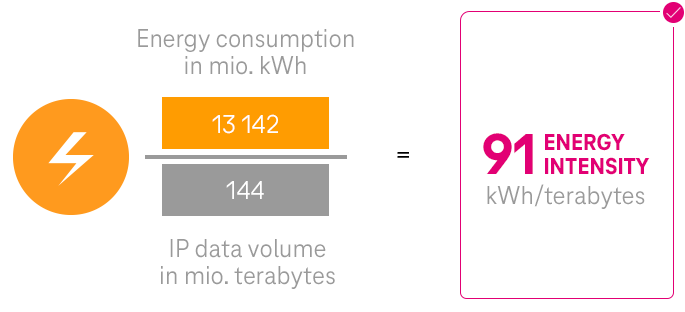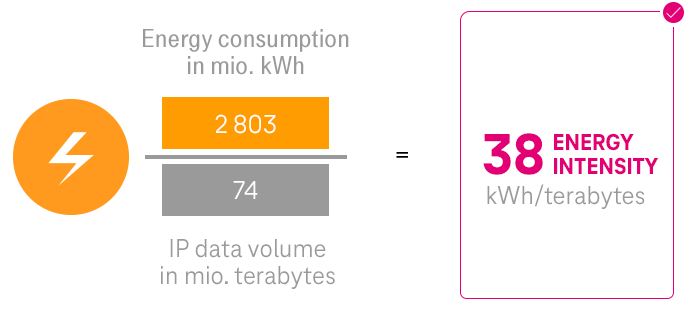Through our interactive benchmarking tool, important facts and figures of our national companies can be analysed and compared.
ESG KPI “Energy Intensity” DT Group KPI
Since 2016, we have reported on the ESG KPI “Energy Intensity.” In contrast to the existing “Energy Consumption”, the new ESG KPI shows energy consumption in proportion to the transmitted data volumes. Using data volume as a reference parameter makes it possible to create a direct link to the performance of our networks.
Our ambition: decrease KPI

Data assured by Deloitte. Data is partly based on estimates, assumptions and projections.
The ESG KPI also takes into account total energy consumption for all energy sources – fuel, gas, district heating and electricity. The data volume is composed of the transmitted IP data volumes (including Voice over IP, Internet, IP-TV).
a) The value for 2019 was corrected compared to the information published in the previous year's report. The subsequent correction results from late notifications for natural gas consumption at Magyar Telekom Hungary and T-Mobile Austria.
Reporting against standards
Global Reporting Initiative (GRI)
- GRI 302-3 (Energy)
Task Force on Climate-related Financial Disclosures (TCFD)
- The most important key figures for measuring and managing climate-related opportunities and risks
- Criterion 12 (Resource Management)
- Principle 7 (Support a precautionary approach to environmental challenges)
European Federation of Financial Analysts Societies (EFFAS)
- E01-01 (Energy consumption)
ESG KPI “Energy Intensity” DT Group in Germany KPI
Since 2016, we have reported on the ESG KPI “Energy Intensity.” In contrast to the existing “Energy Consumption,” the new ESG KPI shows energy consumption in proportion to the transmitted data volumes. Using data volume as a reference parameter makes it possible to create a direct link to the performance of our networks.

Data assured by Deloitte. Data is partly based on estimates, assumptions and extrapolations.
The ESG KPI also takes into account total energy consumption for all energy sources – fuel, gas, district heating and electricity. The data volume is composed of the transported IP data volumes (including IP telephone, internet, IP-TV).
Global Reporting Initiative (GRI)
- GRI 302-3 (Energy)
Task Force on Climate-related Financial Disclosures (TCFD)
- The most important key figures for measuring and managing climate-related opportunities and risks
- Criterion 12 (Resource Management)
- Principle 7 (Support a precautionary approach to environmental challenges)
- Principle 8 (Undertake initiatives to promote greater environmental responsibility)
European Federation of Financial Analysts Societies (EFFAS)
- E01-01 (Energy consumption)
Total energy consumption KPI
Total energy consumption increased by 0.5 percent year over year.

Data verified by Deloitte. Data is partly based on estimates, assumptions and projections. Some of the data originates from external service providers.
Reporting against standards
Global Reporting Initiative (GRI)
- GRI 302-1 (Energy)
- GRI 302-2 (Energy)
Task Force on Climate-related Financial Disclosures (TCFD)
- The most important key figures for measuring and managing climate-related opportunities and risks
Sustainability Accounting Standards Board (SASB)
-
Code TC-TL-130a.1 (Environmental Footprint of Operations)
- Criterion 11 (Usage of Natural Resources)
European Federation of Financial Analysts Societies (EFFAS)
- E01-01 (Energy consumption)
PUE ESG KPI – lower carbon emissions in data centers KPI
We are reducing the carbon emissions of our data centers by optimizing energy consumption and improving processes at the individual data center sites. The Power Usage Effectiveness (PUE) metric serves as one indicator for energy-efficiency enhancements in our data centers. We determine this metric using the method recommended by the standard EN50600 for data centers, which has to take the total energy consumed by data centers into account – and not only that used to operate the servers. The PUE factor is calculated using the ratio between the total electrical energy consumed by the data center and the amount of electrical energy consumed by IT.
In 2022, the average global PUE score for our T-Systems data centers was 1.59. For our data centers in Germany, we reduced the PUE from 1.85 in 2008 to 1.5 in 2022; this value is significantly below the average for all data centers in Germany, which is around 1.8. Our most-efficient high-availability data center has a PUE of 1.3. This will allow us to compensate, in part, for increases in IT systems’ energy requirements as a result of growing volumes of data. Energy consumption is also reduced relative to the increasing processing power of the IT systems as a result of the positive effect on energy efficiency and, by extension, the PUE score. The energy needs of our T-Systems data centers are met entirely from renewable sources.

Data centers are becoming more energy-efficient
As part of the DC11@2018 program, we worked until the end of 2018 to combine data center capacity worldwide in FMO (future mode of operation) data centers with the latest IT technology and hence improved energy efficiency. Physical data center consolidation (reducing data center space and sites) was combined with logical consolidation (virtualizing IT infrastructure). Within the scope of the physical consolidation, we decommissioned several old data centers in Germany.
The follow-up program “Data Center Next” was launched in 2019. Our aim is to further homogenize and virtualize the IT landscape, and to optimize utilization of the data center infrastructure according to IT requirements. The Data Center Next program is making use of efficiency-enhancing options, such as selective cooling of individual areas, and temperature increases within allowed ranges – always in conformance with defined thresholds. With such efforts, we plan to achieve efficiency improvements across the board.
A majority of our high-availability, modern internal FMO twin-core data centers were included in the EU Code of Conduct on Data Centre Energy Efficiency (EU CoC) at the end of 2020. We therefore meet, to a large extent, one of the criteria of the European regulation for sustainable business (EU Taxonomy). At the same time, we are working to further optimize energy efficiency in all data centers.

Sustainability Accounting Standards Board (SASB)
-
Code TC-TL-130a.1 (Environmental Footprint of Operations)
Compliance with the EU Code of Conduct on Data Centre Energy Efficiency
The European Union (EU) introduced the EU Code of Conduct on Data Centre Energy Efficiency in 2008. Its goal is to motivate operators and owners of data centers to reduce energy consumption and hence its negative impact on the environment, the economy, and energy supply security. Companies can join this voluntary initiative, which T-Systems did in 2014. The related EU Commission page provides transparent, detailed information about the participation of individual data centers.
We currently operate a total of 16 FMO twin-core data centers in Europe at eight FMO twin-core sites – eight internally and eight externally – in addition to four local customer-specific data centers. Six of our eight internal European FMO twin-core data centers, and one external FMO twin-core data center, have been included in the EU Code of Conduct list since 2021. The seventh internal European FMO twin-core data center is set to be added to the list in 2023. By taking part in the EU Code of Conduct, T-Systems meets an important criterion for achievement of Taxonomy-conformity under the regulatory initiative for sustainable business activities (EU Taxonomy). More information about our commitment within the framework of the EU Taxonomy is available here.
Our approach to energy-efficient networks
We operate our own fixed-line and mobile networks in Europe and the United States. The majority of our energy requirements come from operating this network infrastructure. To handle growing amounts of data and improve the speed and quality of data transmission, we continuously increase the capacity and performance of our networks. To ensure that our energy consumption grows much less than the amounts of data transmitted, we are pursuing various approaches:
We are also aiming to stabilize our energy consumption and increase our energy efficiency by 2024, in spite of growing data traffic and our network expansion. In a Group-wide technology-innovation project, we are studying and developing new ways of making our network operations even more energy-efficient and sustainable. In the process, we are looking especially carefully at the areas of energy transport, energy availability, and energy efficiency. For example, we plan to optimize energy consumption in our mobile- and fixed-network operations, and to develop innovative solutions for generating and storing renewable energy for use at mobile base stations. The results of these efforts will help us promote energy-efficiency and energy-saving measures in Germany and Europe. In the same vein, some of our European national companies have already been able to reduce their energy consumption via network modernizations.
We are working with a telecommunications supplier in the renewable energy sector to enhance the sustainability and efficiency of the energy generation activities at our mobile base stations. Making integrated use of solar energy at these mobile base stations allows us to optimize energy consumption, as confirmed by initial tests during the period under review. The first successful laboratory tests have also laid the foundation for using zero-emission fuel cells to supply climate-neutral energy to the mobile base stations. We are still in the pilot phase here.
Since 2020, we have been a member of the Solar Impulse Foundation (SIF) 1000+ Solutions Alliance. The aim of the SIF is to identify more than 1 000 solutions that tackle environmental problems – especially those resulting from climate change. For Deutsche Telekom, the focus is on developing technologies for the ICT industry that have a positive impact on reducing carbon emissions, on energy management and energy efficiency, and on the collection and recycling of digital devices. In addition, SIF not only supports the development of solutions like these; it also certifies them. In 2020, it recognized a solution used by Deutsche Telekom in Germany and its partner Cloud&Heat to cool servers using an innovative water-cooling system.
industry that have a positive impact on reducing carbon emissions, on energy management and energy efficiency, and on the collection and recycling of digital devices. In addition, SIF not only supports the development of solutions like these; it also certifies them. In 2020, it recognized a solution used by Deutsche Telekom in Germany and its partner Cloud&Heat to cool servers using an innovative water-cooling system.
Impact assessment for our materiality analysis
In the impact assessment for our materiality analysis, we have identified energy-intensive processes along our value chain. The use of fossil-fuel energy in the upstream and downstream value chain is still widespread, making a particularly large contribution to global warming and placing additional pressures on humans and the environment. The disposal of electronic waste can also pose further problems for the environment and human health.
In order to address these risks, we involve our suppliers in our environmental initiatives as part of our supplier management process.
Do you have questions on this topic?
Heinz-Gerd PetersAsk our expert:
Global Reporting Initiative (GRI)